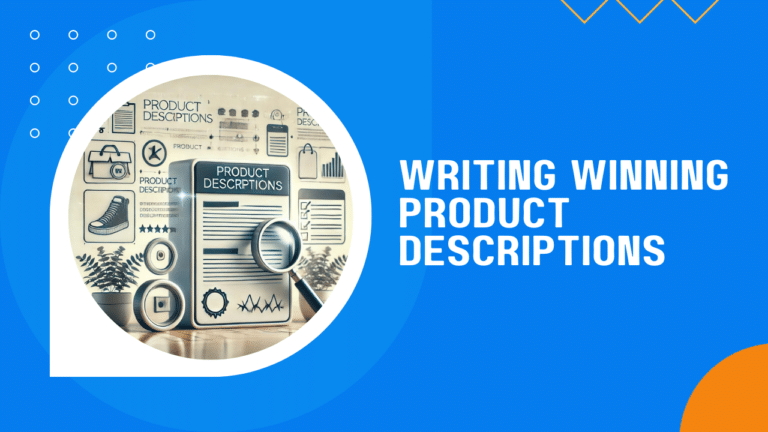Product descriptions are essential tools that directly influence purchasing decisions in ecommerce. A well-crafted product description not only provides details about an item but also convinces customers to make a purchase. These descriptions are key to improving SEO, driving organic traffic, and increasing sales. This guide will provide you with the strategies and best practices needed to create effective product descriptions that engage your audience and drive conversions.
Understanding the Role of Product Descriptions
Product descriptions are more than simple summaries of what an item is—they are strategic tools designed to convert browsers into buyers. A product description serves two primary purposes: informing potential customers and persuading them to make a purchase.
At their core, product descriptions provide essential details about a product’s features, specifications, and uses. However, their true power lies in their ability to address the specific needs and desires of the target audience. By focusing on how a product solves a problem or enhances the customer’s life, these descriptions can influence purchasing decisions more effectively than mere feature lists.
Moreover, product descriptions are vital for targeting specific customer needs. When crafted with the audience in mind, they speak directly to the consumer’s pain points and motivations. This targeted approach not only boosts sales but also strengthens the connection between the brand and the customer, fostering loyalty and repeat business.
In addition to their persuasive power, product descriptions play a crucial role in ecommerce SEO. By integrating relevant keywords naturally, they help improve search engine rankings, making it easier for potential customers to find your products online. This dual function of product descriptions—as both a sales tool and an SEO asset—makes them indispensable in the ecommerce landscape.
Key Elements of a Winning Product Description
1. Know Your Audience
Understanding your target audience is the foundation of writing effective product descriptions. Tailoring the language, tone, and content to match the preferences and needs of your potential customers ensures that the description resonates with them. Whether your audience values technical details or emotional appeal, crafting descriptions that speak directly to their concerns increases the likelihood of conversion.
2. Focus on Benefits Over Features
While it’s important to mention product features, emphasizing the benefits of those features is what truly persuades customers. Rather than just listing technical specifications, explain how the product will solve a problem or improve the customer’s life. For example, instead of saying a smartphone has a “12MP camera,” highlight that it “captures stunning, high-resolution photos that preserve every detail.”
3. Use Descriptive and Sensory Language
Descriptive language that engages the senses helps customers visualize the product in use, making the description more compelling. Words that evoke sight, touch, taste, or sound can create a vivid picture in the customer’s mind, making the product feel more tangible and desirable. For example, “soft, buttery leather” is more engaging than simply saying “leather material.”
4. Tell a Story
Incorporating storytelling into your product descriptions can create an emotional connection with your audience. A story can illustrate how the product fits into the customer’s life, solving a problem or enhancing an experience. For example, instead of just describing a hiking backpack’s features, you could narrate a brief scenario where the backpack makes a challenging hike more enjoyable and hassle-free.
5. Keep It Clear and Concise
Clarity is crucial in ecommerce product descriptions. Avoid jargon and complex language that could confuse or alienate potential buyers. A clear, concise description ensures that the customer understands the product quickly, which is especially important in a fast-paced online shopping environment. Aim to provide all necessary information in a straightforward manner, avoiding unnecessary filler words or overly technical terms.
Writing for SEO
1. Keyword Integration
Incorporating relevant keywords naturally into your product descriptions is essential for improving SEO and ensuring your products are discoverable online. Start by identifying the primary and secondary keywords related to your product. These should include not only the product name and key features but also terms that potential customers might use when searching.
For example, if you’re selling running shoes, keywords like “breathable running shoes” or “lightweight athletic shoes” could be included. However, it’s important to integrate these keywords smoothly into the text so that the description remains readable and engaging.
2. Scannable Formatting
Most online shoppers skim through content rather than reading every word, so making your product descriptions scannable is critical. Use bullet points, subheadings, and bold text to highlight key features and benefits. This not only enhances the user experience but also helps search engines better understand the content of your page.
For example, breaking down a product’s specifications into bullet points makes it easier for customers to quickly find the information they’re looking for, while also making the description more visually appealing.
3. Optimize for Search Engines and Users
Balancing SEO with readability is key. While it’s important to include keywords, they should never disrupt the flow of the text or feel forced. Prioritize creating a description that is both informative for the user and optimized for search engines. This involves writing naturally, avoiding keyword stuffing, and focusing on delivering value to the customer. Search engines reward content that is user-friendly, so always keep the reader’s experience in mind while ensuring your content is well-optimized.
By following these SEO practices, your product descriptions will not only rank higher in search engine results but will also provide a better user experience, leading to increased visibility and sales.
Practical Tips and Best Practices
1. Avoid Clichés and Exaggeration
Using overused phrases or making exaggerated claims can damage the credibility of your product descriptions. Phrases like “best on the market” or “once-in-a-lifetime deal” tend to be perceived as empty marketing jargon. Instead, focus on providing specific, honest details that highlight the product’s unique strengths. Authenticity resonates with customers and builds trust, which is crucial for driving conversions in ecommerce.
2. Incorporate Social Proof
Including elements of social proof in your product descriptions can significantly enhance credibility and persuade potential buyers. Social proof can take many forms, such as customer reviews, testimonials, or endorsements from influencers.
For example, mentioning that “95% of customers recommend this product” or quoting a positive review can provide reassurance to shoppers, making them more likely to complete a purchase.
3. Test and Refine
The effectiveness of product descriptions can often be improved through testing and refinement. Conduct A/B tests on different versions of descriptions to determine which one resonates best with your audience. You might test different tones, lengths, or formats to see what drives higher conversion rates. Regularly reviewing and updating product descriptions based on performance data helps ensure they remain relevant and effective over time.
By applying these practical tips, you can craft product descriptions that not only inform but also persuade, ultimately leading to better customer engagement and higher sales.
4. Scale With AI
AI has come a long way in its ability to generate content, and is most effective when given a set of rules and parameters to follow. To help with that, we created a free AI product description generator you can use to help build product descriptions for your site.
Examples of Effective Product Descriptions
1. Example 1: Apple iPhone 13
Description: “The Apple iPhone 13 features a Super Retina XDR display that delivers vibrant colors and incredible detail, making everything from photos to videos look stunning. Powered by the A15 Bionic chip, it offers lightning-fast performance for gaming, streaming, and multitasking. With 5G capabilities, you can download and stream on the go at remarkable speeds. The iPhone 13 also boasts a durable design with Ceramic Shield and water resistance, ensuring it can handle whatever life throws at you.”
Why It’s Effective: This description highlights both the technical features and the benefits they provide, such as enhanced durability and performance. The language used is clear and engaging, while the focus on the product’s ability to improve the user’s experience makes it compelling.
2. Example 2: Patagonia Nano Puff Jacket
Description: “The Patagonia Nano Puff Jacket is your go-to for warmth without the bulk. Featuring PrimaLoft® insulation, this jacket provides exceptional warmth, even when wet, while remaining lightweight and packable. Perfect for hiking, camping, or everyday wear, it offers a windproof and water-resistant shell that keeps you protected in unpredictable weather. Plus, it’s made from 100% recycled polyester, making it a sustainable choice for the environmentally conscious.”
Why It’s Effective: This description uses sensory language to help customers envision the comfort and practicality of the jacket. It also emphasizes the environmental benefits, appealing to eco-conscious shoppers. The inclusion of specific features like “PrimaLoft® insulation” and the jacket’s versatility makes it attractive to a wide audience.
3. Example 3: Dyson V11 Torque Drive Cordless Vacuum
Description: “The Dyson V11 Torque Drive Cordless Vacuum gives you the power of a full-size vacuum with the convenience of cordless. Engineered for deep cleaning, it automatically adjusts suction and power to deep clean carpets and hard floors. With up to 60 minutes of fade-free power, you can tackle even the largest cleaning jobs without interruption. The advanced filtration system captures 99.97% of particles as small as 0.3 microns, expelling cleaner air into your home.”
Why It’s Effective: This description effectively combines technical details with benefits, clearly explaining how the product improves the user’s cleaning experience. The emphasis on features like the automatic suction adjustment and advanced filtration addresses common customer needs, making the product more appealing.
These examples illustrate how to apply the strategies discussed in this guide, showing how product descriptions can be both informative and persuasive. By focusing on the benefits, using descriptive language, and including social proof, you can create compelling descriptions that drive conversions.
Final Thoughts
Creating effective product descriptions is a crucial skill for any ecommerce business looking to increase sales and improve customer engagement. By understanding your audience, emphasizing benefits over features, using descriptive language, and optimizing for SEO, you can craft descriptions that not only inform but also persuade. Incorporating social proof and continuously testing and refining your approach will further enhance the effectiveness of your product listings. Apply these strategies to your own ecommerce site, and watch as your product descriptions drive more conversions and build stronger connections with your customers.









